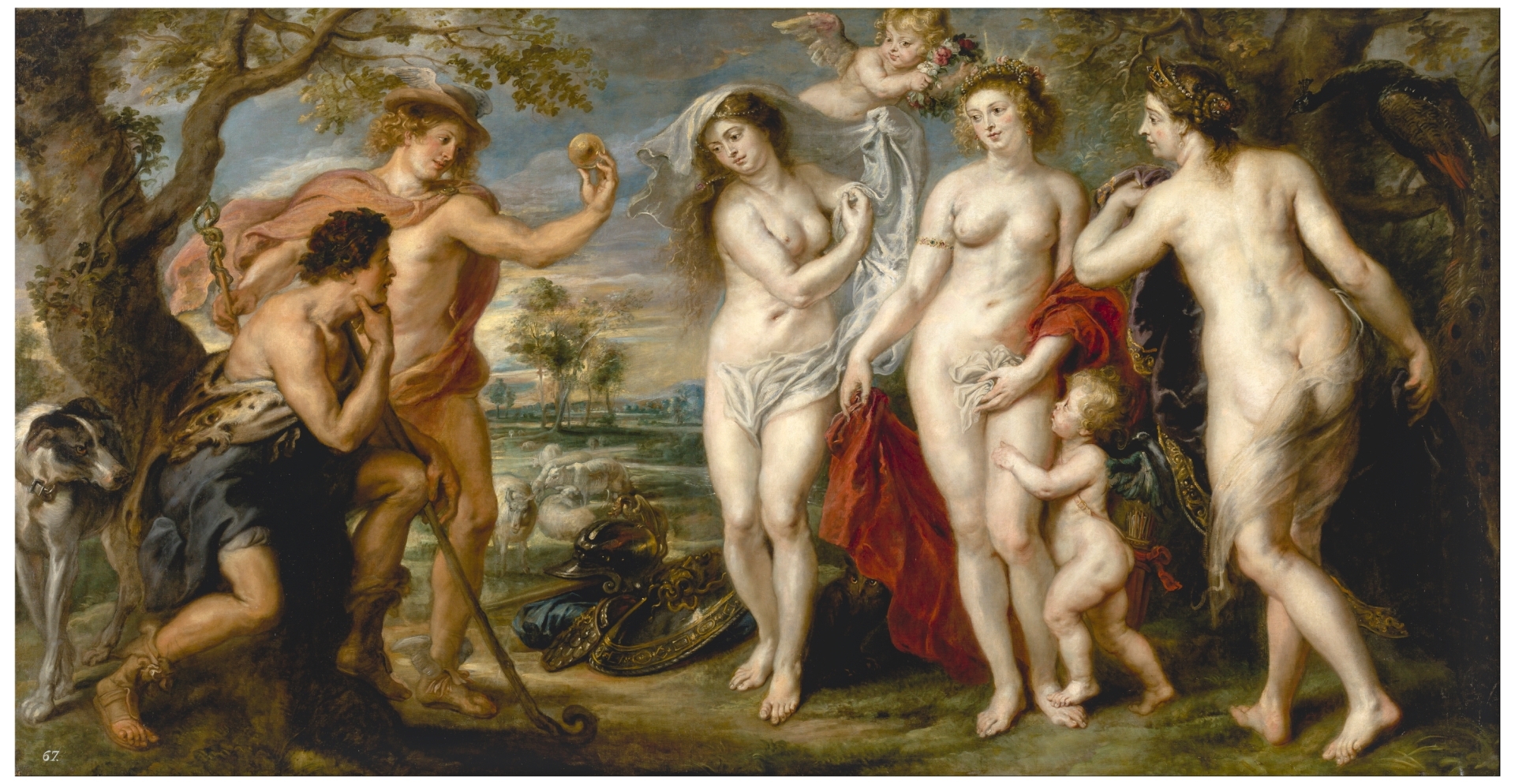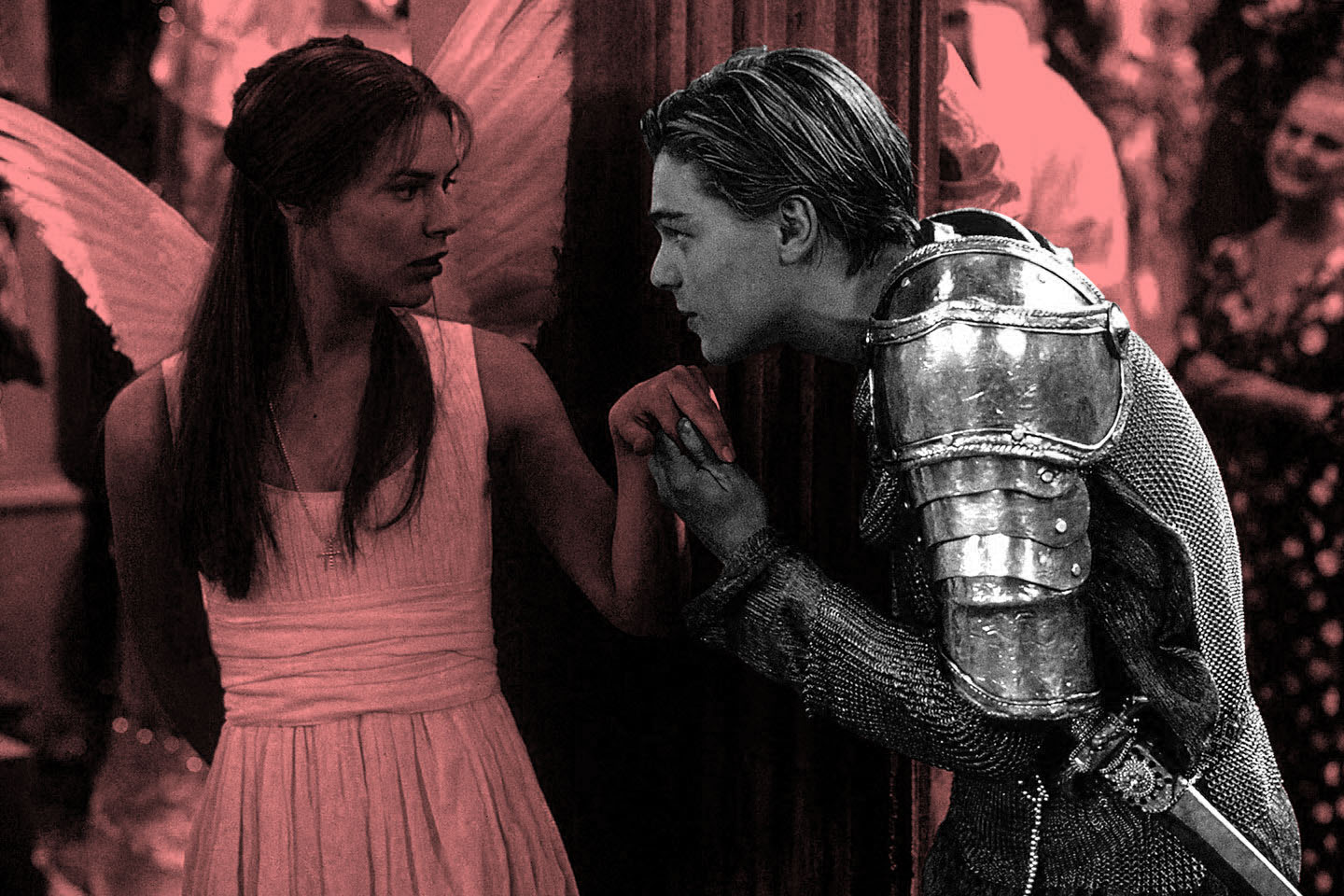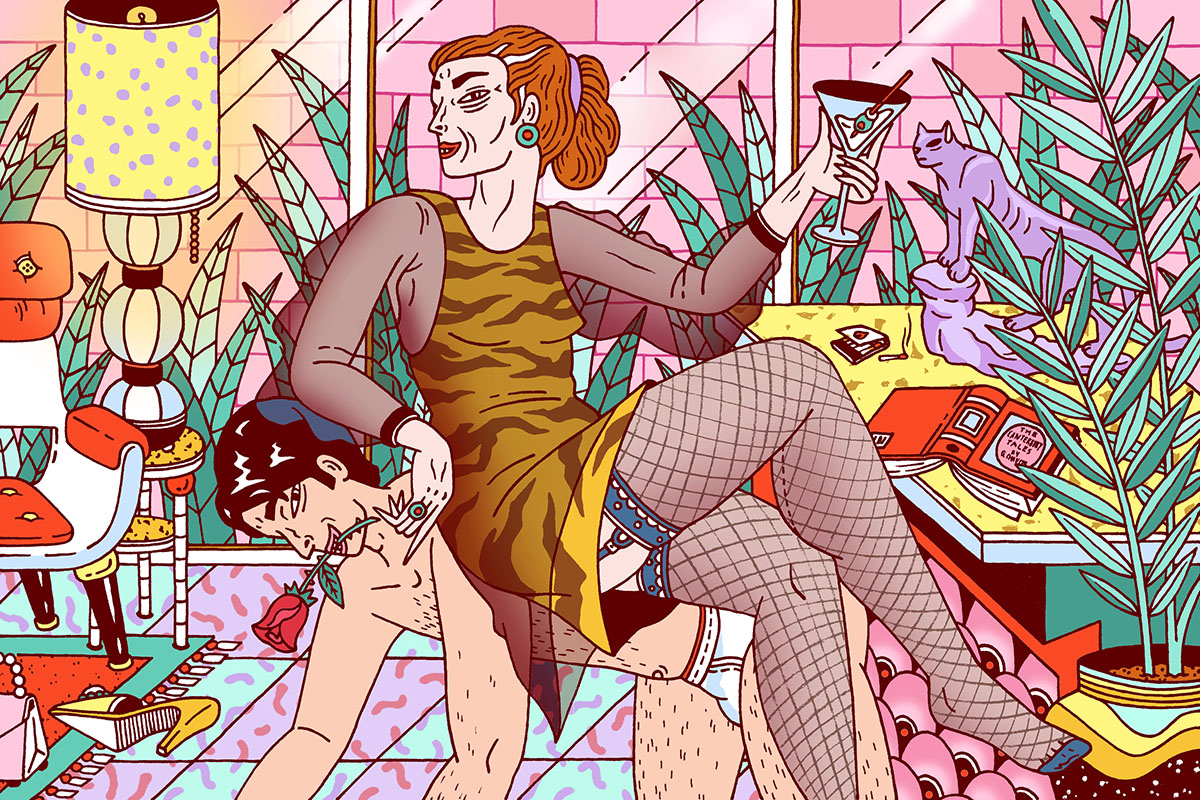Three goddesses stood before a young man, naked. They wore nothing but promised him everything. Well, actually, they each promised him one thing: a potent bribe. The stakes had never been higher. This was, after all, the world’s first beauty contest.
Goddess number one appealed to the young man’s ambition. If he crowned her most beautiful, she would give him control of Europe and Asia. Goddess number two offered unlimited knowledge. If the young man chose her, he would become the wisest mortal in the world.
The third goddess possessed neither the power of the first nor the intelligence of the second. But she had something her peers lacked: a preternatural understanding of the male libido. As she leaned over the young man, he inhaled the sweet aroma of her heavily perfumed flesh.
“Pick me,” she crooned, “and I will give you the most beautiful woman in the world.”
Game, set, match.
The young man’s name was Paris. His prize was Helen. On their first night together, her mind raced.
She had just been abducted and raped, again, this time with the aid of a goddess. Were trauma and despair all a woman could expect in this world? What would happen to her children, now motherless in the sole custody of a callous father?
Across the Aegean Sea, Menelaus, the king of Sparta, erupted. His wife had just been stolen by the pretty-boy prince of Troy. He was now a cuckold, husband to an unfaithful wife, the lowest position a man could occupy in this world. To retrieve his property and reclaim his dignity, Menelaus called on all the kings of Greece to join him in battle. Bound by sworn oaths, they obliged.
The ensuing conflict is immortalized in Homer’s epic poems The Iliad and The Odyssey. The Trojan War, the most famous in all of literature, started because a vengeful husband was willing to burn the world to repair the damage to his fragile ego.

The word “cuckold” has trended a few times in recent months. On July 10, Jada Pinkett Smith summoned a special guest to her “Red Table Talk” series on Facebook: herself. Will Smith, her husband of 23 years, joined her. During their candid 13-minute conversation, Pinkett Smith acknowledged an extramarital “entanglement” with the singer August Alsina while she and Smith were separated several years ago. This private disclosure triggered a vociferous public reaction.
Gossip rags obsessed over whether the couple has an open marriage, and keyboard misogynists railed against Pinkett Smith. In an especially disturbing display of toxic masculinity, a new TikTok trend emerged in which young men harass women with the explicit goal of making “them” (i.e., women) pay for Pinkett Smith’s transgression. For these men, it’s as if their own masculinity is under attack because Will Smith’s wife slept with someone else while they were separated.
The loudest reactions to the “Red Table Talk” episode, however, were aimed at Pinkett Smith’s husband. Tweets that addressed Will Smith ranged from mocking schadenfreude to vitriol. Strangers goaded him with a slew of insults — “cuck,” “beta,” “simp” — and turned screenshots of his agonized face into a 2020 version of Crying Jordan. It didn’t take long for social media to brand Smith, one of America’s most self-assured leading men, a cuckold.
Smith was not the only high-profile male to wear a scarlet “C” this summer. In late August, a story broke about another extramarital affair, this time involving Jerry Falwell Jr., his wife Becki and their pool boy Giancarlo. Falwell, the controversial Evangelical leader, allegedly enjoyed watching his wife have sex with Giancarlo. This sexual practice, known as “cuckolding,” is consistently one of the most searched categories on major porn sites. According to a researcher at The Kinsey Institute, cuckolding is a fantasy that appeals disproportionately to conservative men. In the wake of this scandal, Falwell, like Smith, has been roasted on social media.
There are substantial differences between these men and the circumstances of their summer headlines. Smith is widely revered, Falwell is generally reviled. Smith is being called a cuckold due to (perceived) infidelity, Falwell for pursuing an erotic fetish. Yet there are also similarities. Both situations relate to the private lives of adults, which is why I’m uncomfortable even writing about them in a public way. But the public response to each is what strikes me as the most concerning aspect of these stories. Concerning but not surprising. Within Western culture there is a long tradition of lampooning cuckolds. If art offers a window into cultural consciousness, an examination of the cuckold’s appearance in literature reveals why it is stealthily one of history’s most dangerous archetypes.
***
“The Miller’s Tale” is one of the bawdier stories in Geoffrey Chaucer’s 14th-century masterpiece The Canterbury Tales. It is an example of a fabliaux, a type of story characterized by sexual and scatalogical humor. With several fart jokes and what might be the first canonical ass-to-mouth scene, it lives up to the genre. It also offers a satirical yet realistic take on the fear that consumed many medieval husbands.
Early in the story, we meet a curmudgeonly carpenter named John and his new wife Alison. Translated from the Middle English courtesy of Harvard:
She was eighteen years of age.
Jealous [John] was, and held her narrowly in confinement,
For she was wild and young, and he was old
And believed himself likely to be a cuckold.
John’s paranoia becomes self-fulfilling. He treats Alison like a prisoner in her own home. Meanwhile, under the same roof, John rents a room to a slick Oxford scholar named Nicholas. Slick Nick studies astrology, plays guitar and is described as an expert in “secret love and its satisfaction.” You’ll never guess what happens next.
After Nicholas seduces Alison, he uses his astrology background to convince John of a second coming of Noah’s flood. He persuades John to build wooden tubs that they can hang from the rafters to avoid getting washed away at night. When John starts snoring, Alison and Nicholas sneak out of their tubs and fornicate. One night, John awakes suddenly. Believing the flood has arrived, he frantically cuts his tub loose and crashes to the ground. The commotion attracts witnesses:
The neighbors, both low-ranking and high,
Run in to gawk at this man,
Who yet lay in a swoon, both pale and wan,
For with the fall he had broken his arm.
As John writhes and sputters gibberish about a flood, Nicholas and Alison arrive and tell everyone he is crazy. An important point here is that all of the neighbors, regardless of caste, are united in mocking the cuckold. The town, emblematic of society, enjoys a hearty laugh at John’s expense. So too does Chaucer’s reader.
“The cuckold is a stock comic figure of medieval ribaldry,” write Mark Millington and Alison Sinclair in their 1992 essay “The Honourable Cuckold.” “Here is a man we are invited to laugh at, to ridicule because his wife has found her sexual satisfaction outside the marriage bed.”
The cuckold is the butt of the joke in “The Miller’s Tale” and many similar stories. “The presence of the cuckold trope in fabliaux lends an interesting importance to the fear of marital infidelity,” writes historian Maureen Smith, “which in turn suggests an interesting link between cuckolding and hegemonic masculinity.”
In his 1990 book Manhood in the Making, anthropologist David Gilmore argues that medieval masculinity centered around three defining traits: the ability to offer physical protection, the ability to provide for a family and the ability to impregnate women (which also implied sexual prowess, since medieval doctors believed that women, like men, needed an orgasm in order to conceive). A wife’s decision to cheat, therefore, was viewed as a condemnation of her husband’s masculinity. The cuckold was treated as a failure of evolution.
“While all the cuckolds [in fabliaux] are used to comedic effect, they are also objects of scorn,” Smith writes. “No man would want to find himself in their position, and the subtle moral is that men should take great pains to make sure they do not end up cuckolds.”
It would be centuries before writers started exploring the darker implications of this attitude.
Elizabethan playwrights got a lot of mileage out of an archetype known as the “imaginary cuckold.” This is a popular trope in 17th-century comedies: a jealous husband wrongly suspects his wife of infidelity and hatches a plan to exact revenge on her and her purported lover. Just before he achieves this goal, more rational minds emerge to foil his plot and point out the folly of his thinking. The wife is absolved and the husband is humiliated.
The imaginary cuckold is a useful device to “dramatize the peril and absurdity of the misdirected imagination,” Shakespearean Russ McDonald observes. “But in Othello such a figure becomes the hero of a tragedy, and the traditional reaction, scornful laughter, is inadequate.”
Part of William Shakespeare’s genius was his ability to manipulate audience expectations. Othello is a play about an imaginary cuckold, but Shakespeare uses his audience’s familiarity with the convention to deliver a much starker message about the relationship between jealousy and the unbridled imagination.
“The dangers that in comedy are defused by the discovery of error are realized in the final act of Othello,” McDonald writes. “The deluded husband fulfills his threat.”
Many critics blame Iago, Othello’s devious ensign, for the murder of Desdemona, Othello’s faithful wife. This view is misguided. The only person to blame is her husband. But Iago is a terribly effective gaslighter. From Act Three:
Oh, beware, my lord, of jealousy!
It is the green-eyed monster which doth mock
The meat it feeds on. The cuckold lives in bliss
Who, certain of his fate, loves not his wronger.
By warning Othello against jealousy, Iago unleashes the monster. Iago is guilty of inception, but Othello is the murderer. His fear of becoming a cuckold, which Iago implies here, is deeply entwined with societal views on masculinity. A few scenes later, believing himself to be a cuckold, Othello exclaims, “A horned man’s a monster and a beast.”
(An interesting aside on etymology: the word cuckold comes from the French cucu, for cuckoo bird, because some female avian species lay their eggs in other birds’ nests for them to raise. In literature, there are many references to cuckolds having horns. This stems from another animal comparison: stags forfeit their mates when they lose a duel against another male. In many cultures today, making a horn gesture at a man is akin to calling him a cuckold. Remember the harmless bunny ears you used to make behind your buddy on picture day? That is also rooted in cuckold-shaming.)
Returning to Othello, it is the trauma of thinking he has become one of these “horned,” sub-human creatures that tears his ego apart. As jealousy overpowers his imagination, Othello’s inner turmoil is externalized as a desire to kill Desdemona.
“I will chop her into messes!” Othello coldly tells Iago. “Cuckold me?”
The most tragic moment in the play occurs after Othello strangles Desdemona. She is clinging to life when her maid, Emilia, finds her. “Who hath done this deed?” Emilia asks.
“Nobody,” Desdemona utters. “I myself.”
***
One of the reasons Othello is such a powerful text is because it illuminates troubling truths about domestic violence for both victims and abusers. It is not uncommon for victims and survivors to blame themselves, just like Desdemona does with her dying breath. Othello’s pattern of psychological and physical abuse is also prevalent in real life.
“Jealousy and imagined infidelity are huge tools for abusive partners, particularly abusive men,” says Ruth Glenn, the CEO of the National Coalition Against Domestic Violence. “If they need to gain and maintain control, they usually imagine this other relationship. It becomes a tool of control where they may abuse someone over and over again.”
The role of cultural inputs cannot be ignored in terms of fomenting misogyny and stoking the flames of jealousy inside an abuser’s imagination. The definitions of words like “cuck,” “beta” and “simp” vary, but they all carry the same connotation that is attached to the medieval view of the cuckold. Their intent is to emasculate men who don’t subscribe to hegemonic masculinity, and their effect is to condone — either tacitly or stridently — a culture of misogyny.
“Language is very, very powerful, and in some ways can say more about who we are, what we value, what our ideology is, than we know,” Glenn tells InsideHook. She has a simple message for the young men who casually throw these words around: think about them critically.
“When you use that type of language, you’re positioning someone in a position that you find unfavorable. And particularly terms [like ‘cuck’ and ‘simp’], they really are anti-woman,” Glenn says. “So if you’re using that language against another man, it’s really demonstrating how much you objectify women.”
***
Comedic representations of the cuckold archetype are problematic for a number of reasons. When the cuckold is the butt of the joke, as in Chaucer’s “Miller’s Tale,” the audience’s laughter reinforces an inherently misogynistic worldview. When the character is self-deprecating, like Andy Bernard, he endorses this worldview by acknowledging his inferiority as a man. These particular plots are resolved without violence — narrowly, in The Office — but they perpetuate the stigmas that are associated with the archetype. When a reader or viewer encounters horrific violence that occurs in response to infidelity (real or imagined), it becomes much easier to rationalize or even condone the act.
In an 1878 essay entitled “Wife Torture in England,” Frances Power Cobbe set out to determine “why the male of the human species, and particularly the male of the finest variety of that species [English], should be the only animal in creation which maltreats its mate, or any female of its own kind.” One of her conclusions was that British society tolerated and even made light of domestic violence.
Cobbe specifically mentions “Punch and Judy,” a folktale puppet act that first appeared in England in the 17th-century. Punch and Judy shows are still performed today. The plotlines have evolved over the years, but the premise is the same: the main character, Mr. Punch, is a buffoon who beats other puppets that mock him. His wife, Judy, is a frequent victim. Many iterations of the show imply that Judy is unfaithful. In this 2008 performance, you can hear an audience of children giggle as Punch chokes and thrashes Judy.
With this kind of cultural conditioning, it’s no wonder Will Smith has faced so much derision. There are many aspects of the “Red Table” episode that seem fair to criticize. The entire segment is heavily produced — the couple’s unified chant, “We ride together, we die together, bad marriage for life,” punctuated with a fistbump, feels contrived — and the whole thing could be interpreted as yet another display of Hollywood narcissism.
But I’m choosing to view it differently. If you watch the video — and I suspect many of the loudest haters haven’t — you see Will Smith act like a man who is hurt and vulnerable and totally at peace with the fact that his wife’s life is her own. This is not the kind of reaction our culture is comfortable accepting. Even Pinkett Smith had doubts.
“I didn’t know if you’d be willing to find the deep capacity to love me,” she says near the end of the video.
“How am I doing?” Smith asks.
“You’re doing fucking great,” she tells him.
For loving his wife unconditionally, the internet mocked Will Smith and questioned his manhood. The reality is that he showed us what a real man looks like.
The Charge will help you move better, think clearer and stay in the game longer. Subscribe to our wellness newsletter today.





















